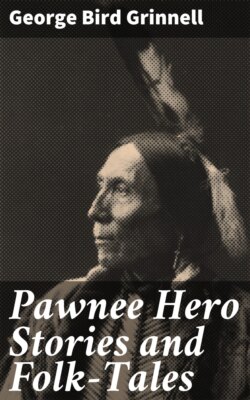Читать книгу Pawnee Hero Stories and Folk-Tales - George Bird Grinnell - Страница 8
На сайте Литреса книга снята с продажи.
V.
ОглавлениеKut-a´wi-kutz then stayed with the Comanches. The Cheyennes came north and east, and the Comanches went on west, nearer to the mountains. While the Pawnee was with the Comanches, they had several wars with the Utes, Lipans and Tonkaways. Kut-a´wi-kutz proved himself a brave man, and, as the son-in-law of the chief, he soon gained great influence, and was himself made a chief.
After some years the old man, his wife’s grandfather, told the Pawnee that he thought it was time that he should eat some of those things that he had long wanted to eat that grew up north; that he was getting pretty old now. Kut-a´wi-kutz said, “It is time. We will go.” So he had his horses packed, and with his immediate family and the old man, started north toward the Pawnee country. At this time he was called Kut-a´wi-kutz-u si-ti´-da-rit, which means “See! The Hawk.” When going into battle he would ride straight out to strike his enemy, and the Comanches who were looking at him would say, “See! The Hawk.” So that became his name.
They traveled a long time until they came to the Pawnee ground. As they were traveling along, they came to a field where were growing corn, beans and squashes. The Pawnee said to the old man, “Grandfather, look at that field. There are the things that you have desired to eat.” He got off his horse and went into the field, and pulled some corn, some beans and some squashes, and took them to the old man, and gave them to him. The old man supposed they were to be eaten just as they were, and he tried to bite the squashes. This made the Pawnee laugh. When they came to the village, the Pawnees were very glad to see him who had been lost long ago. He told the people that he had brought these Indians to eat of the corn and other things; that they were his kinsfolk. He told them, too, about the young man who had killed himself. His relations went out into the fields, and gathered corn and beans and squashes, and cooked them for the Comanches.
They stayed there a long time at the Pawnee village. When they were getting ready to return, the Pawnees dried their corn, and gave a great deal of it to the Comanches, packing many horses with it for the Indians at home. Then the Comanches started south again, and some of the Pawnee young men, relations of Kut-a´wi-kutz, joined him, and went back with them. After they had returned to the Comanche camp, the old grandfather died, happy because he had eaten the things he wanted to eat.
Soon after this, Kut-a´wi-kutz started back to the Pawnee village, and some young men of the Comanches joined him. Some time after reaching the village he went south again, accompanied by some young Pawnees, but leaving most of the Comanches behind. He had arranged with the chiefs of the Pawnees that they should journey south, meet the Comanches on the plains and make peace. When he reached the Comanches, the whole village started north to visit the Pawnees, and met them on their way south. When they met, the two tribes made friends, smoked together, ate together, became friends.
After they had camped together for some time, some Comanches stayed in the Pawnee camp, and some Pawnees in the Comanche camp. Kut-a´wi-kutz was called by the Pawnees Comanche Chief. He would have remained with the Comanches, but when he went back with them his wife fell sick. The Comanche doctors could not help her, and he wanted to take her north to see the Pawnee doctors, but the Comanches would not let him. They kept him there, and his wife died. Then he was angry, for he thought if he had taken her north her life might have been saved.
So he left the Comanches, and went and lived with the Pawnees, and was known among them always as Comanche Chief, the Peace-Maker, because he made peace between the Pawnees and Comanches. He was chief of the Ski´-di band, and a progressive man of modern times. He sent his children East to school at Carlisle, Pa.
Comanche Chief died September 9th, 1888.
